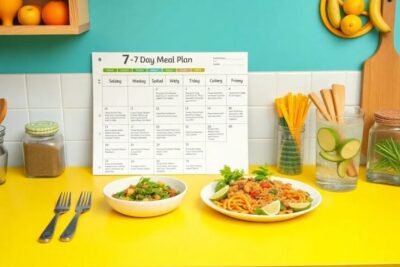
Delicious Diabetic-Friendly Meals for Kids
- Understanding Diabetes in Children
- The Importance of Balanced Nutrition
- Diabetic Meal Planning Essentials
- Kid-Friendly Diabetic Recipes
- Healthy Snack Options for Kids
- Making Mealtime Fun and Engaging
- Addressing Common Challenges
- Continuing Education and Resources
- Conclusion: Empowering Healthy Choices
Understanding Diabetes in Children
Diabetes is a chronic condition that affects how the body processes glucose, the primary source of energy. In children, two main types of diabetes are most commonly diagnosed: Type 1 and Type 2. Type 1 diabetes occurs when the immune system mistakenly attacks the insulin-producing cells in the pancreas, leading to little or no insulin production. Children with this type are dependent on insulin therapy for their survival. Conversely, Type 2 diabetes is increasingly prevalent and is often associated with obesity and inactivity. It results from the body's inability to effectively use insulin or a relative lack of insulin production.
The causes of diabetes in children can vary. Genetic predisposition plays a significant role, along with environmental factors such as diet and activity level. Symptoms of diabetes may include frequent urination, increased thirst, fatigue, and blurred vision. In Type 1 diabetes, symptoms often arise suddenly, while Type 2 symptoms can develop gradually and may go unnoticed for a time. Early detection and management are crucial in preventing complications associated with uncontrolled diabetes.
Proper dietary management is essential for children diagnosed with diabetes. This is where diabetic-friendly meals for kids come into play. Creating meal plans that focus on balanced nutrition helps maintain stable blood glucose levels, supporting the child's overall growth and development. Meals designed for children with diabetes often include a harmonious mix of carbohydrates, healthy fats, and proteins. Incorporating a variety of whole foods such as vegetables, proteins, and whole grains is key to developing a diet that can provide necessary nutrients without spiking blood sugar levels.
In conclusion, understanding the complexities of diabetes in children is imperative for parents and caregivers. By focusing on tailored meal plans and diabetic-friendly meals for kids, one can significantly improve the quality of life and health outcomes for children managing this condition.
The Importance of Balanced Nutrition
Balanced nutrition serves as the cornerstone for the health and well-being of children diagnosed with diabetes. Crafting diabetic friendly meals for kids necessitates a comprehensive understanding of essential nutrients, which include carbohydrates, proteins, fats, vitamins, and minerals. Each of these components plays a vital role in maintaining optimal health and managing blood sugar levels effectively.
Carbohydrates often receive significant attention in diabetic meal planning, as they can directly influence blood glucose levels. However, it is important to focus on the quality of carbohydrates rather than merely the quantity. Whole grains, fruits, and vegetables are excellent sources of complex carbohydrates that are generally digested more slowly, helping to stabilize blood sugar levels. Furthermore, incorporating sources of lean protein—such as chicken, fish, beans, and legumes—can complement carbohydrate intake and contribute to satiety, thus preventing overeating.
Healthy fats are also an integral aspect of a balanced diet for diabetic children. Incorporating sources such as avocados, nuts, and olive oil can support overall health while helping to maintain energy levels. Additionally, vitamins and minerals must not be overlooked, as they are required for numerous bodily functions, including immune support and energy production. A diverse range of colorful fruits and vegetables can provide these essential nutrients, ensuring that meals are not only nourishing but also visually appealing to children.
In addition to focusing on nutrient-rich foods, portion control and meal timing play crucial roles in supporting stable blood sugar levels. It is advisable to serve moderate portions and to schedule meals and snacks consistently throughout the day. This can prevent spikes in blood glucose and promote better overall management. Understanding how to create diabetic friendly meals for kids is not just about choosing the right foods; it involves a holistic approach to nutrition and lifestyle for sustained health benefits.
Diabetic Meal Planning Essentials
Planning diabetic-friendly meals for kids is crucial for managing their health while ensuring they enjoy nutritious and delicious foods. The core principle behind meal planning for children with diabetes is to create balanced meals that maintain stable blood sugar levels. A meal plan should primarily focus on foods that are low in sugar and high in fiber, which can be achieved by incorporating whole foods such as vegetables, fruits, whole grains, and lean proteins.
First, it is important to consider carbohydrate counting, as this practice helps in predicting the child's blood sugar response. Whole grain options like brown rice, quinoa, and whole wheat bread not only provide essential nutrients but also help regulate blood sugar levels thanks to their high fiber content. Fiber-rich foods slow down glucose absorption, aiding in blood sugar control. Include a variety of vegetables, particularly non-starchy options such as broccoli, spinach, and bell peppers, to enhance fiber intake without adding excessive carbohydrates.
Involving children in the meal planning and preparation process can be beneficial for their understanding of nutrition and healthy eating habits. When they help with selecting recipes or cooking, it fosters a sense of ownership over their food choices. Kids are more likely to try new diabetic-friendly meals for kids when they have a hand in making them. Encourage them to experiment with ingredients, helping them learn about balance and moderation as they gain confidence in the kitchen.
Moreover, establishing a regular eating schedule is essential for maintaining consistent blood sugar levels. This can help prevent spikes and drops in glucose, which is important in managing diabetes. By knowing when meals and snacks occur, both children and caregivers can be better prepared. Planning ahead and making use of a weekly menu can ease the pressure of last-minute meal decisions and contribute to healthier eating practices.
Kid-Friendly Diabetic Recipes
Preparing meals for children with diabetes can be a challenging task, particularly when it comes to making food that is both nutritious and appealing. Fortunately, a variety of delightful and nutritious meal options are available, ensuring that diabetic-friendly meals for kids are not only beneficial but also enjoyable. Here are some easy-to-prepare recipes that will cater to young palates while supporting blood sugar control.
One such recipe is the Veggie-Packed Mini Pizzas. Using whole wheat pita bread as the base, simply spread a thin layer of tomato sauce, sprinkle with low-fat cheese, and add an array of colorful vegetables like bell peppers, spinach, and cherry tomatoes. These mini pizzas can be baked until the cheese is melted, creating a visually appealing dish that kids will love. The combination of whole grains and vegetables makes this meal both diabetic friendly and nutritious.
Another excellent option is Healthy Banana Oat Pancakes. Blend together rolled oats, ripe bananas, and a dash of cinnamon, forming a thick batter. Cook the pancakes on a non-stick skillet, allowing them to turn golden brown. These pancakes not only provide a sweet treat for breakfast or a snack but are rich in fiber and provide sustained energy without causing spikes in blood glucose levels.
The Rainbow Vegetable Stir-Fry offers a bright and colorful option that’s appealing to children. Simply sauté a mix of colorful vegetables like broccoli, carrots, and snap peas in a small amount of olive oil or low-sodium soy sauce. Pairing this dish with brown rice or quinoa can create a filling meal that’s both diabetic friendly and packed with nutrients.
In conclusion, through careful selection of ingredients and creative preparations, it is possible to create delicious diabetic-friendly meals for kids. Emphasizing variety in flavors and textures not only enhances the appeal of these meals but also encourages healthy eating habits among children, supporting their well-being and diabetes management. By incorporating these recipes into regular meal planning, parents can foster a positive relationship with food for their kids while ensuring they receive the necessary nutrients.
Healthy Snack Options for Kids
Providing healthy snack options for children with diabetes can be straightforward yet enjoyable. A balanced approach focuses on incorporating low-glycemic foods that can help maintain stable blood sugar levels while also appealing to young palates. One excellent option is fresh fruits like berries, apples, or pears, which are not only nutritious but also rich in fiber. Offering these fruits with a small amount of nut butter can make them more satisfying and provide a healthy dose of protein.
Another great way to create diabetic-friendly meals for kids is through the use of whole grain crackers paired with cheese. This combination offers a well-rounded option that delivers complex carbohydrates alongside protein and fat, which can aid in maintaining stable glucose levels. Similarly, homemade vegetable sticks such as carrots, cucumbers, or bell peppers can be served with hummus, a tasty dip that adds flavor and nutrients without spiking blood sugar.
For a touch of sweetness, consider making yogurt parfaits with low-fat yogurt topped with nuts and seeds, as they are both filling and beneficial for overall health. Opt for unsweetened varieties to keep sugar content low. Additionally, air-popped popcorn can serve as a fun and light snack, seasoned with herbs or a sprinkle of cheese for flavor without overdoing it on carbohydrates.
It is crucial to be mindful of portion sizes and to ensure the snacks chosen align with the individual's dietary requirements. Encouraging children to participate in snack preparation can make the experience more engaging and enjoyable, fostering healthier eating habits. Smart snacking is essential not only for maintaining energy levels but also for preventing unwanted blood sugar spikes. Parents can create a well-rounded snack plan that supports the health of their diabetic children while ensuring they enjoy the foods they eat.
Making Mealtime Fun and Engaging
Turning mealtime into a fun and engaging experience is crucial for children, especially those with diabetes. When kids feel involved in the process of creating their meals, they are more likely to appreciate healthy eating and develop a positive relationship with food. One effective strategy is to encourage children to participate in meal preparation. This can include tasks such as washing vegetables, measuring ingredients, or even assembling their plates. By engaging them in these activities, children gain a sense of ownership over their meals and are often more excited to consume diabetic friendly meals for kids.
Presentation also plays a significant role in making meals appealing. Utilizing a variety of colors and shapes can turn an ordinary plate into a vibrant feast for the eyes. For example, creating a colorful salad with mixed greens, cherry tomatoes, bell peppers, and cucumber can captivate a child's attention. Similarly, arranging fruits in fun shapes or using cookie cutters to make sandwiches can add a playful element to the dining table. Such visual appeal not only makes healthy options more enticing but also encourages kids to try new diabetic friendly meals for kids that they might otherwise overlook.
Incorporating educational elements into mealtime can further stimulate children's interest. Discussing the nutritional benefits of different ingredients can be an enlightening experience. Explaining how certain foods contribute to their health and energy levels can empower kids to make better choices and understand the importance of a balanced diet. This is especially pertinent for children with diabetes, as they must learn to navigate food choices carefully. Engaging them in conversations about their meals can transform mealtime from a mere routine into an exciting opportunity for learning and growth.
By combining involvement in meal preparation, appealing presentation, and educational discussions, parents can effectively make mealtime a fun and engaging experience for their children, fostering a healthier approach to food choices.
Addressing Common Challenges
Parents of children living with diabetes often encounter a variety of challenges that can impact meal planning and overall well-being. One of the most significant issues is dealing with picky eaters. Many children are selective about their food, which can make it difficult to introduce diabetic friendly meals for kids that are nutritious and appealing. To combat this, parents can involve children in the meal preparation process. By allowing them to choose ingredients or even help cook, kids may become more inclined to try new foods, making it easier to introduce healthier options.
Another common challenge arises during social situations where food is present, such as birthday parties or school events. Children may feel different from their peers and be reluctant to partake in foods that are not suitable for their dietary needs. To address this, parents can communicate with other parents about the child's dietary restrictions ahead of events. Additionally, preparing diabetic friendly meals for kids to bring along to these gatherings can ensure that they have enjoyable and safe food options. This proactive approach not only helps children feel included but also fosters a sense of normalcy around food.
The emotional aspects of managing diabetes should not be overlooked. It's essential for parents to create a supportive environment where children feel comfortable discussing their feelings about their condition and dietary restrictions. Open communication can help alleviate feelings of isolation and frustration. Furthermore, connecting with support groups, either online or within the community, can provide valuable resources and advice for both parents and children. Such support systems offer a platform for sharing experiences, recipes, and tips for maintaining a healthy lifestyle with diabetic friendly meals for kids.
Continuing Education and Resources
Education plays a vital role in managing diabetes, especially for children. Understanding diabetes not only helps children make better food choices but also empowers parents to support their kids in leading healthy lives. When it comes to diabetic friendly meals for kids, knowledge becomes a key element in ensuring nutritious options are readily available. Continuous learning offers insights into balancing carbohydrate intake, recognizing the importance of portion control, and understanding food labels, all of which are crucial in maintaining stable blood sugar levels.
Various organizations and websites provide valuable resources tailored specifically for families managing diabetes. For instance, the American Diabetes Association offers comprehensive guides that cover meal planning, creating diabetic friendly meals for kids, and engaging activities to help children understand their condition. Similarly, the Centers for Disease Control and Prevention (CDC) has educational materials that focus on nutrition for kids with diabetes, which can be essential for parents seeking to integrate healthy eating habits into their family routines.
Support groups can also serve as a significant resource. Joining local or online communities can connect families with others facing similar challenges. These groups often share tips, recipes, and practical advice on preparing diabetic friendly meals for kids. Furthermore, engaging with these communities helps to foster a sense of belonging, alleviating the feelings of isolation that can accompany managing a chronic condition.
Moreover, local healthcare providers, dietitians, and diabetes educators can be invaluable assets. These professionals can offer personalized guidance, provide resources for meal planning, and assist families in establishing healthy habits that accommodate a child’s dietary restrictions. Investing time in education not only enhances knowledge but also equips families to devise effective strategies for long-term health management.
In conclusion, ongoing education and access to resources play a crucial role in effectively managing diabetes in children. By becoming informed and involved, families can navigate the challenges of diabetes management and create a supportive environment where diabetic friendly meals for kids can flourish.
Conclusion: Empowering Healthy Choices
Making informed dietary choices is essential for children with diabetes, as it lays the foundation for their overall health and well-being. By adopting diabetic friendly meals for kids, parents can significantly influence their children’s eating habits and health outcomes. Such meals not only help in managing blood sugar levels but also instill a sense of responsibility and awareness regarding nutrition from an early age.
It is crucial for parents to understand that creating a balanced diet does not mean compromising on taste or satisfaction. On the contrary, introducing a variety of flavorful diabetic friendly meals for kids can encourage them to explore different types of foods while still meeting their nutritional needs. This approach fosters an environment where healthy eating is viewed positively, rather than as a limitation.
When children are involved in the meal planning and cooking processes, they are more likely to embrace these dietary changes. Families can explore new recipes together, turning the preparation of diabetic friendly meals for kids into a fun and educational experience. This not only empowers children to make healthier choices but can also strengthen family bonds through shared activities.
Additionally, promoting a positive dining atmosphere enhances the eating experience, where children feel supported in their dietary choices. Engaging discussions around food, its health benefits, and the importance of balanced meals can stimulate children's curiosity and encourage them to take charge of their nutrition. By fostering these practices, parents are setting their children on a path toward lifelong healthy habits that they will carry into adulthood.
In conclusion, embracing diabetic friendly meals for kids is a powerful step towards ensuring their health and wellbeing. Through informed choices, family involvement, and a supportive environment, parents can empower their children to lead a healthy lifestyle that adapts to their unique needs.










